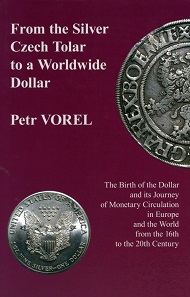Written by Ursula Kampmann
Translated by Leonie Schulze
February 21, 2019 – Talers have been enthusiastically collected for centuries. Due to their size, their representative design and, of course, their price, collecting talers is generally considered the showcase discipline of numismatics. After all, there is a reason why the world’s most expensive coin, which sold for more than 10 million US dollars, was the first American silver dollar. Precisely because of this widespread interest, numerous auction catalogs dedicated to the history of the taler have been published. However, most of them merely depict individual pieces, then tell you where and when they were created – and that’s about it. Until now, we were still missing a full-scale study of monetary history elucidating the reasons why the taler of all coins prevailed. Now, we have one: Petr Vorel, economic historian and prorector at the Czech University of Pardubice, has compiled an extensive study in which he describes the rise of the taler from the first guldiner from Hall up to the first currencies that were based on the dollar in the early days of the 20th century.
Petr Vorel, From the Silver Czech Tolar to a Worldwide Dollar. The Birth of the Dollar and its Journey of Monetary Circulation in Europe and the World from the 16th to the 20th Century. Columbia University Press 2013. 198 pp. and 80 colored and grey-scale plates. Hardcover. 16.3 x 23.5 cm. ISBN: 978-0-88033-705-2. 43 GBP.
Those who regard the taler primarily a currency of the German Empire, might consider his approach somewhat unusual as he looks slightly east in his analysis. It starts off with Sankt Joachimsthal being correctly listed under its Czech name Jáchymov.
If you continue reading, you’ll learn – and this might come as a surprise to most collectors – that the Joachimstaler products were less a means of payment than a commodity used to transport silver from the Bohemian part of the Ore Mountains to other countries. In order to fully understand who was responsible for the minting of Joachimstaler guldinger, the author unravels the entire history of Bohemia. Needless to say, he also focuses on the fate of the Counts of Schlick (Slikové). And he follows the changes inherent to the transition from the reign of the Jagiellonian king Louis II to Ferdinand I of Habsburg. The question of the extent to which controlling the Bohemian silver influenced its owner’s position of power, is omnipresent in these accounts.
Hence, we continue to trace the path of the taler through various discussions about a standardized silver multiple for the whole empire during the Diet convened by Charles V. We observe how the Spanish eight-reales pieces Philipp II had minted to finance his religious wars, circulated as Philippstaler in the German Empire, and how all European powers created silver multiples, whose weight and fineness was adapted to national preferences and conventions.
The following chapter focuses on the trade of silver from the New World and its influence on the rise of the taler to world currency status. Here, the author forges a bridge that spans the entire world and takes us straight to the present day – to be exact, he takes us to Bermuda, the Caribbean, Australia, Fiji and, last but not least, to the Slovenian tolar currency that was introduced after the country declared independence in 1991.
Petr Vorel recounts the history of the taler-dollar in a precise and compelling way while avoiding the Germany-centric view many of us are used to. He lives up to the book’s title and focuses on the developments in Jáchymov / Joachimsthal. Those chapters that deal with the Bohemian contribution to said evolution present a lot of unknown, exciting and anything but self-evident content.
Reading “From the Silver Czech Tolar to a Worldwide Dollar” is truly rewarding, especially since after finishing it, you will have understood that there used to be “talers” and “talers”, meaning those “talers” that are rare and nice to look at, that are expensive to purchase in auctions, but played little to no role in the development of the currency – and the few other types (Bohemian and Spanish ones in particular) which set the course for a global currency.
A small stock of copies is currently available at Amazon USA for the low and reduced price of $11.95 (+ $24.95 in shipping and packaging for Europeans). To be honest, I would pay even more to get my hands on this book. It is an absolute must-read!





